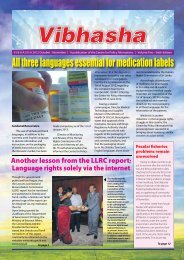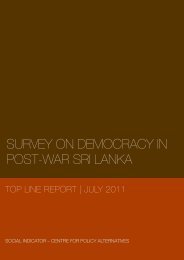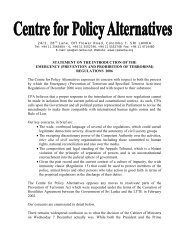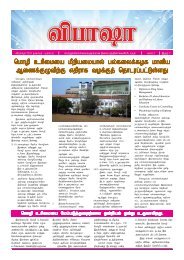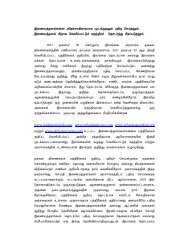States of Emergency - Centre for Policy Alternatives
States of Emergency - Centre for Policy Alternatives
States of Emergency - Centre for Policy Alternatives
Create successful ePaper yourself
Turn your PDF publications into a flip-book with our unique Google optimized e-Paper software.
natural disasters, and a negative list in respect <strong>of</strong> security‐related<br />
or man‐made crises. 122<br />
Indeed, the South African bill <strong>of</strong> rights (both in terms <strong>of</strong> breadth<br />
and depth <strong>of</strong> scope, and the general limitations clause) in general,<br />
and Section 37 in particular, represents perhaps the best<br />
international practice in the protection <strong>of</strong> fundamental human<br />
rights during a time <strong>of</strong> emergency. 123 Among the human rights<br />
safeguards built into the South African emergency regime is the<br />
procedural framework which gives a central role to the legislature<br />
over declaration, and comprehensive judicial review over all<br />
aspects <strong>of</strong> emergencies. On the other hand are the substantive<br />
protections including the list <strong>of</strong> non‐derogable rights, the explicit<br />
establishment <strong>of</strong> limits on permissible derogations, and the<br />
domestic justiciability <strong>of</strong> international human rights within the<br />
emergency regime. Together, these are what Klug calls the ‘own<br />
internal rules <strong>of</strong> interpretation’ <strong>of</strong> the South African bill <strong>of</strong><br />
rights. 124 Against such a sophisticated treatment <strong>of</strong> human rights<br />
in states <strong>of</strong> emergency, the Sri Lankan framework seems<br />
rudimentary and primitive.<br />
As in the South African case, some constitutions make reference to<br />
the State’s international obligations in respect <strong>of</strong> international<br />
human rights instruments and their derogation standards. 125<br />
These are highly constructive sources <strong>of</strong> both positive rights as<br />
122<br />
For examples <strong>of</strong> all three approaches, see Gross and Ní Aoláin: p.8<br />
123<br />
Cheadle, Davis & Haysom (2002), op cit., Ch.31<br />
124<br />
Heinz Klug, ‘South Africa: From Constitutional Promise to Social <br />
Trans<strong>for</strong>mation’ in Jeffrey Goldsworthy (2006) Interpreting <br />
Constitutions: A Comparative Study (Ox<strong>for</strong>d: Ox<strong>for</strong>d UP): Ch.6 at p.281<br />
125<br />
Another example is Article 23 <strong>of</strong> the Finnish Constitution<br />
82



